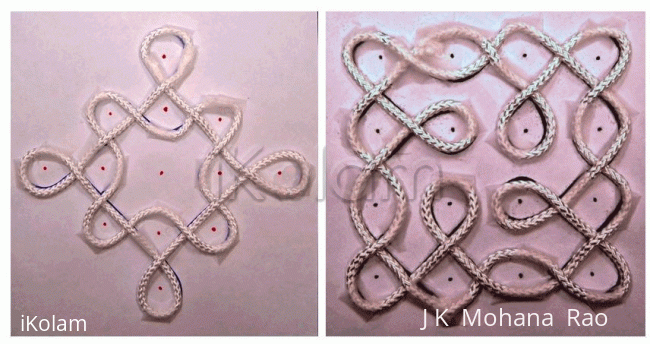rangOli with strings
About rangOli with strings : PRINT
I have created two ordinary well-known rangOlis with strings.
Why with strings? The lines have no thickness. Therefore if one draws rangOlis
with lines, then the third dimension is lacking. So mirror reflections are quite
common. But since strings have thickness, these types of symmetries are eliminated.
We get only pure rotational symmetries in the rangOlis. In each of the given rangOlis,
there are two strings that interweave. One can see these alternately going up
and down. Since I used nylon material, the strings are taut and I have to use
cellophane tape so that the strings follow the pattern drawn on paper.
Please feel free to comment. Regards! - mOhana





Comments
Lata
Wed, 2009-03-25 17:33
Permalink
"Cool!", is what my daughter said.
I'm still staring at it. Good micromanagement!!
I'm trying to think of all the brands of tape that I know of. I see that some sort of a tape is affixed to the strings, but how come the edges are not visible at all?
My hunch is, this kind of tape must be available only for ___?
Lata
Wed, 2009-03-25 17:34
Permalink
How do they do that?
-Surya
Lata
Wed, 2009-03-25 17:38
Permalink
ok, I see that it is cellotape, I was surprised to see it so seamless!
jkmrao
Thu, 2009-03-26 04:12
Permalink
By the way, I forgot to mention in my text above. These string rangOlis have the
quality of handedness. These and their mirror images are quite different in the
way in which the up and down movements of strings take place. That means these
are chiral.
Regards! - mOhana
Hemabose
Thu, 2009-03-26 04:15
Permalink
Hi, Nice work ... Iam not nit picking.. but this is not a RANGOLI.. this is a KOLAM.. neenga tamil thana.. Sikku kolam sollalame.. illa string kolam sollalame..
Rangoliyoda artham is different. its a colorfull art work...
jkmrao
Thu, 2009-03-26 11:27
Permalink
namastE /\
ranga means stage and in the case of rangOlis, it can be the frontyard or the place of
worship or a stage or a manTapa. valli or vallika means creeper. The word rangavalli(ka)
literally means a creeper or some such pattern on a stage. The word rangOli is a
popular variant of the word rangavalli. To draw the various patterns, the placement
of dots is of great help. The dots can be arranged basically in two ways - rectangular
grid or an isometric (hexagonal} grid. The first one is what is commonly called
straight and the second one is what goes by the name in-between. The dots are like
guideposts and help in drawing the patterns. Now are dots really necessary for drawing
rangOlis? If people have good geometrical insights, they can draw them without these.
One of the artists on this forum has given many examples drawn freehand. For many of
those, we can place dots and then they become dotted patterns. There are other works
that are mainly artistic without much symmetry like the vinAyaka of another artist that
has dots. In this case, we can remove the dots too and the art will not suffer or lose
its beauty. I do not agree with the definition or nomenclature of calling artistic works
only as rangOlis and the rest as kOlams. Any way in the kannaDa speaking households,
those that have dots and those that do not have dots, all are called rangOlis.
I am not making it up. Please read the poem I translated and the original also
in the poems section where the mention of rangOli and chukke (dots) are mentioned
in the same poem. Again people can use terms with which they are comfortable as it
is quite easy to understand what they really mean.
Regards! - mOhana